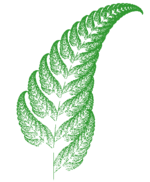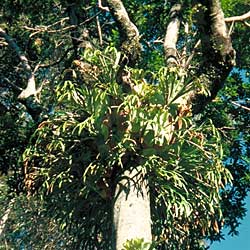sekejap ku teringat akan masa lalu,
dan itu takkan mungkin kembali
walau jiwa ini memaksa untuk kembali ke masa itu
kini q tlah dewasa
banyak sesuatu yang harus q lakukan
banyak hal2 yg blum bsa kupahami
banyak hal2 yg perlu kupelajari
banyak tanggungan yg hrus q selesaikan
banyak rintangan menuju revolusi perubahan
kini ku harus mengubah cara pandang n berfikir
tak cukup itu saja
q jg hrs memperbaiki smuanya
tingkah laku,kepribadian
ttap jg hati ,jgn smpai kmaksiatan
trus menghantui...
biarpun hati t' dpt membohongi....
jk bnar rasa itu hdir
tnpa kusadari...
____sprti ap yg Qrskan dkalbuku___
_Kni Q psrhkn smua padaMu_
Selamat datang cinta
Selamat untuk menyemaikan benih-benih
kerinduan dan kasih sayang dalam qalbuku
Tumbuhkanlah jiwa-jiwa pengorbanan
untuk membahagiakan Sang Cinta
Selimutilah kebekuan hatiku
dengan hangat dan santunnya tutur katamu
Keteduhan senyuman dan raut wajahmu
membuat sejuk semilir angin berembus dihatiku...
Temanilah kesendirianku
dengan siraman motivasi dan semangatnu
Pupuklah cinta itu dengan ,
keCintaanmu kepada-Nya
Sang Kekasih abadi
Perindahlah background keislamanmu
dengan pakaian keimanan dan ketakwaan
Percantiklah cintamu
dengan indahnya lantunan ayat-ayat Al Quran
Sebarkanlah benih-benih kerinduan
akan keindahan harumnya Surga
Perbanyaklah sujudmu
untuk terkabulnya permohonan doa
Perharumlah cintamu
dengan kesabaran da keikhlasan
Walau cinta kadang menyesakkan
dan tak jarang kebencian menghalangi tumbuhnya cinta
Jagalah cintamu,
rawatlah dia
bahagiakanlah Dia
dan peluk eratlah Dia
Mohonlah perlindungan-Nya
Untuk mengharumkan
Lafaz Cinta
Ya Allah ,alhamdulillah,siang ini aku mempersembahkan yg terbaek bwt ustadzahq.Selasa,21 April 2009 aq dg rasa percaya diriku menampilkan sebuah puisi karyaq sendiri"Aisyah Fitriyah".Puisi tersebut adalah bentuk perasaan dri diri saya,saat mengalami kefuturan dan keputusasaan.Saya berusaha untuk memotivasi diri,agar tidak terlalu menyesal karna kegagalan itu.Pernah salah seorg guru sy melemahkan smangat sy dg teguran karna tdk memperhatikan pelajarannya ,saat ulangan.So,hsl ulangan harian saya jeblog...dbwh standard yang saya bwt...<75.saya>75 dan =76.Alhamdulillah mnempati peringkat ke-4 mapel tsb.Bkn hnya mapel ini sj tp jg smua mapel yang belum mencapai ketuntasan yg sy bwt,sy janji akan memperbaikinya.Insya Allah ujian smstr 2 nanti hsilnya lebih baik dan target2 yg tlah sy bwt berhasil terlaksana.
Jalan yang Ku Tempuh
Kala burung berkicau memamerkan kemerduan nyanyiannya
maka diri ini pun tersadar
bangkit dan kembali melangkah
untuk melanjutkan perjuangan
tidak ada kata untuk sakit dan mengeluh
Karena itu hanyaakan menghancurkan
smangat yang telah kita bangun
Biarlah darah ini habis demi memperjuangkan agamaku
Biarlah diri ini terluka demi melindungi smangat perjuangan
Biarlah tubuh ini lelah demi mewujudkan cita-cita
Walau perjuangan ini belum seberapa
takkan mungkin aku akan mundur
hanya karna kegagalan yang terjadi
Siapa yang takkan bersedih jika gagal datang
Siapa yang takkan kecewa jika hasil kurang sempurna
Siapa yang takkan terluka jika kita dihina
Ya Rabb...
Jangan biarkan hambaMu ini dalam keputusasaan
Jangan biarkan hambaMu ini dalam kehampaan
Jangan biarkan hambaMu ini dalam kefuturan
Biarlah luka ini menjadi obat bahagia kelak
Biarlah perjuangan ini menjadi bukti kecintaanku Pada-Mu
Biarlah perjalanan ini menjadi pelajaran memaknai hidup
Kebahagiaan takkan terwujud tanpa derita
Kesuksesan takkan tercapai tanpa kerja keras
Kemuliaan takkan tercapai tanpa ketaqwaan
Maju untuk berjaya,mundur untuk sengsara
Maju untuk makmur,mundur untuk tersungkur
Maju dan terus berjuang itu pilihanku
perih perjuangan adalah kekuatan bagiku
Smangat ku kian menggebu
Karna Kau slalu
menemani setiap langkahku
Aisyah Fitriyah
Kupersembahkan pada:
- Ustadzah Fadila
- Ustad/h smuanya
- Umi Abi
- Smua kawan2 yg slalu memotivasiku
| Ferns (Pteridophyta) Fossil range: Mid Devonian[1] — Recent | ||||
|---|---|---|---|---|
Athyrium filix-femina unrolling young frond  | ||||
| Scientific classification | ||||
| ||||
| Classes | ||||
|
Life cycle
Ferns are vascular plants differing from the more primitive lycophytes by having true leaves (megaphylls). They differ from seed plants (gymnosperms and angiosperms) in their mode of reproduction — lacking flowers and seeds. Like all other vascular plants, they have a life cycle referred to as alternation of generations, characterized by a diploid sporophytic and a haploid gametophytic phase. Unlike the gymnosperms and angiosperms, the ferns' gametophyte is a free-living organism.
Life cycle of a typical fern:
- A sporophyte (diploid) phase produces haploid spores by meiosis;
- A spore grows by mitosis into a gametophyte, which typically consists of a photosynthetic prothallus
- The gametophyte produces gametes (often both sperm and eggs on the same prothallus) by mitosis
- A mobile, flagellate sperm fertilizes an egg that remains attached to the prothallus
- The fertilized egg is now a diploid zygote and grows by mitosis into a sporophyte (the typical "fern" plant).
Fern ecology
The stereotypic image of ferns growing in moist shady woodland nooks is far from being a complete picture of the habitats where ferns can be found growing. Fern species live in a wide variety of habitats, from remote mountain elevations, to dry desert rock faces, to bodies of water or in open fields. Ferns in general may be thought of as largely being specialists in marginal habitats, often succeeding in places where various environmental factors limit the success of flowering plants. Some ferns are among the world's most serious weed species, including the bracken fern growing in the British highlands, or the mosquito fern (Azolla) growing in tropical lakes, both species forming large aggressively spreading colonies. There are four particular types of habitats that ferns are found in: moist, shady forests; crevices in rock faces, especially when sheltered from the full sun; acid wetlands including bogs and swamps; and tropical trees, where many species are epiphytes.
Many ferns depend on associations with mycorrhizal fungi. Many ferns only grow within specific pH ranges; for instance, the climbing fern (Lygodium) of eastern North America will only grow in moist, intensely acid soils, while the bulblet bladder fern (Cystopteris bulbifera), with an overlapping range, is only found on limestone.
Fern structure
Like the sporophytes of seed plants, those of ferns consist of:
- Stems: Most often an underground creeping rhizome, but sometimes an above-ground creeping stolon (e.g., Polypodiaceae), or an above-ground erect semi-woody trunk (e.g., Cyatheaceae) reaching up to 20 m in a few species (e.g., Cyathea brownii on Norfolk Island and Cyathea medullaris in New Zealand).
- Leaf: The green, photosynthetic part of the plant. In ferns, it is often referred to as a frond, but this is because of the historical division between people who study ferns and people who study seed plants, rather than because of differences in structure. New leaves typically expand by the unrolling of a tight spiral called a crozier or fiddlehead. This uncurling of the leaf is termed circinate vernation. Leaves are divided into three types:
- Trophophyll: A leaf that does not produce spores, instead only producing sugars by photosynthesis. Analogous to the typical green leaves of seed plants.
- Sporophyll: A leaf that produces spores. These leaves are analogous to the scales of pine cones or to stamens and pistil in gymnosperms and angiosperms, respectively. Unlike the seed plants, however, the sporophylls of ferns are typically not very specialized, looking similar to trophophylls and producing sugars by photosynthesis as the trophophylls do.
- Brophophyll: A leaf that produces abnormally large amounts of spores. Their leaves are also larger than the other leaves but bear a resemblance to trophopylls.
- Roots: The underground non-photosynthetic structures that take up water and nutrients from soil. They are always fibrous and are structurally very similar to the roots of seed plants.
The gametophytes of ferns, however, are very different from those of seed plants. They typically consist of:
- Prothallus: A green, photosynthetic structure that is one cell thick, usually heart or kidney shaped, 3–10 mm long and 2–8 mm broad. The prothallus produces gametes by means of:
- Antheridia: Small spherical structures that produce flagellate sperm.
- Archegonia: A flask-shaped structure that produces a single egg at the bottom, reached by the sperm by swimming down the neck.
- Rhizoids: root-like structures (not true roots) that consist of single greatly-elongated cells, water and mineral salts are absorbed over the whole structure. Rhizoids anchor the prothallus to the soil.
One difference between sporophytes and gametophytes might be summed up by the saying that "Nothing eats ferns, but everything eats gametophytes." This is an over-simplification, but it is true that gametophytes are often difficult to find in the field because they are far more likely to be food than are the sporophytes.
Evolution and classification
Ferns first appear in the fossil record in the early-Carboniferous period. By the Triassic, the first evidence of ferns related to several modern families appeared. The "great fern radiation" occurred in the late-Cretaceous, when many modern families of ferns first appeared.
Ferns have traditionally been grouped in the Class Filices, but modern classifications assign them their own division in the plant kingdom, called Pteridophyta.
Traditionally, three discrete groups of plants have been considered ferns: two groups of eusporangiate ferns — families Ophioglossaceae (adders-tongues, moonworts, and grape-ferns) and Marattiaceae — and the leptosporangiate ferns. The Marattiaceae are a primitive group of tropical ferns with a large, fleshy rhizome, and are now thought to be a sibling taxon to the main group of ferns, the leptosporangiate ferns. Several other groups of plants were considered "fern allies": the clubmosses, spikemosses, and quillworts in the Lycopodiophyta, the whisk ferns in Psilotaceae, and the horsetails in the Equisetaceae. More recent genetic studies have shown that the Lycopodiophyta are only distantly related to any other vascular plants, having radiated evolutionarily at the base of the vascular plant clade, while both the whisk ferns and horsetails are as much "true" ferns as are the Ophioglossoids and Marattiaceae. In fact, the whisk ferns and Ophioglossoids are demonstrably a clade, and the horsetails and Marattiaceae are arguably another clade. Molecular data — which remain poorly constrained for many parts of the plants' phylogeny — have been supplemented by recent morphological observations supporting the inclusion of Equisetaceae within the ferns, notably relating to the construction of their sperm, and peculiarities of their roots (Smith et al 2006, and references therein).
One possible means of treating this situation is to consider only the leptosporangiate ferns as "true" ferns, while considering the other three groups as "fern allies". In practice, numerous classification schemes have been proposed for ferns and fern allies, and there has been little consensus among them. A new classification by Smith et al. (2006) is based on recent molecular systematic studies, in addition to morphological data. This classification divides ferns into four classes:
- Psilotopsida
- Equisetopsida
- Marattiopsida
- Polypodiopsida
The last group includes most plants familiarly known as ferns. Modern research supports older ideas based on morphology that the Osmundaceae diverged early in the evolutionary history of the leptosporangiate ferns; in certain ways this family is intermediate between the eusporangiate ferns and the leptosporangiate ferns.
The complete classification scheme proposed by Smith et al. (2006; alternative names in brackets):
- Class Psilotopsida
- Order Ophioglossales
- Family Ophioglossaceae (incl. Botrychiaceae, Helminthostachyaceae)
- Order Psilotales
- Family Psilotaceae (incl. Tmesipteridaceae)
- Order Ophioglossales
- Class Equisetopsida [=Sphenopsida]
- Order Equisetales
- Family Equisetaceae
- Order Equisetales
- Class Marattiopsida
- Order Marattiales
- Family Marattiaceae (incl. Angiopteridaceae, Christenseniaceae, Danaeaceae, Kaulfussiaceae)
- Order Marattiales
- Class Pteridopsida [=Filicopsida, Polypodiopsida]
- Order Osmundales
- Family Osmundaceae
- Order Hymenophyllales
- Family Hymenophyllaceae (incl. Trichomanaceae)
- Order Gleicheniales
- Family Gleicheniaceae (incl. Dicranopteridaceae, Stromatopteridaceae)
- Family Dipteridaceae (incl. Cheiropleuriaceae)
- Family Matoniaceae
- Order Schizaeales
- Family Lygodiaceae
- Family Anemiaceae (incl. Mohriaceae)
- Family Schizaeaceae
- Order Salviniales
- Family Marsileaceae (incl. Pilulariaceae)
- Family Salviniaceae (incl. Azollaceae)
- Order Cyatheales
- Family Thyrsopteridaceae
- Family Loxomataceae
- Family Culcitaceae
- Family Plagiogyriaceae
- Family Cibotiaceae
- Family Cyatheaceae (incl. Alsophilaceae, Hymenophyllopsidaceae)
- Family Dicksoniaceae (incl. Lophosoriaceae)
- Family Metaxyaceae
- Order Polypodiales
- Family Lindsaeaceae (incl. Cystodiaceae, Lonchitidaceae)
- Family Saccolomataceae
- Family Dennstaedtiaceae (incl. Hypolepidaceae, Monachosoraceae, Pteridiaceae)
- Family Pteridaceae (incl. Acrostichaceae, Actiniopteridaceae, Adiantaceae, Anopteraceae, Antrophyaceae, Ceratopteridaceae, Cheilanthaceae, Cryptogrammaceae, Hemionitidaceae, Negripteridaceae, Parkeriaceae, Platyzomataceae, Sinopteridaceae, Taenitidaceae, Vittariaceae)
- Family Aspleniaceae
- Family Thelypteridaceae
- Family Woodsiaceae (incl. Athyriaceae, Cystopteridaceae)
- Family Blechnaceae (incl. Stenochlaenaceae)
- Family Onocleaceae
- Family Dryopteridaceae (incl. Aspidiaceae, Bolbitidaceae, Elaphoglossaceae, Hypodematiaceae, Peranemataceae)
- Family Oleandraceae
- Family Davalliaceae
- Family Polypodiaceae (incl. Drynariaceae, Grammitidaceae, Gymnogrammitidaceae, Loxogrammaceae, Platyceriaceae, Pleurisoriopsidaceae)
- Order Osmundales
Economic uses
Ferns are not as important economically as seed plants but have considerable importance. Some ferns are used for food, including the fiddleheads of bracken, Pteridium aquilinum, ostrich fern, Matteuccia struthiopteris, and cinnamon fern, Osmunda cinnamomea]. Diplazium esculentum is also used by some tropical peoples as food.
Ferns of the genus Azolla are very small, floating plants that do not look like ferns. Called mosquito fern, they are used as a biological fertilizer in the rice paddies of southeast Asia, taking advantage of their ability to fix nitrogen from the air into compounds that can then be used by other plants.
A great many ferns are grown in horticulture as landscape plants, for cut foliage and as houseplants, especially the Boston fern (Nephrolepis exaltata). The Bird's Nest Fern, Asplenium nidus, is also popular, and the staghorn ferns, genus Platycerium, have a considerable following.
Several ferns are noxious weeds or invasive species, including Japanese climbing fern (Lygodium japonicum), mosquito fern and sensitive fern (Onoclea sensibilis). Giant water fern (Salvinia molesta) is one of the world's worst aquatic weeds. The important fossil fuel coal consists of the remains of primitive plants, including ferns.
Ferns have been studied and found to be useful in the removal of heavy metals, especially arsenic, from the soil[3]
Other ferns with some economic significance include:
- Dryopteris filix-mas (male fern), used as a vermifuge, and formerly in the US Pharmacopeia; also, this fern accidentally sprouting in a bottle resulted in Nathaniel Bagshaw Ward's 1829 invention of the terrarium or Wardian case
- Rumohra adiantoides (floral fern), extensively used in the florist trade
- Osmunda regalis (royal fern) and Osmunda cinnamomea (cinnamon fern), the root fiber being used horticulturally; the fiddleheads of O. cinnamomea are also used as a cooked vegetable
- Matteuccia struthiopteris (ostrich fern), the fiddleheads used as a cooked vegetable in North America
- Pteridium aquilinum (bracken), the fiddleheads used as a cooked vegetable in Japan and are believed to be responsible for the high rate of stomach cancer in Japan. It is also one of the world's most important agricultural weeds, especially in the British highlands, and often poisons cattle and horses.
- Diplazium esculentum (vegetable fern), a source of food for some native societies
- Pteris vittata (brake fern), used to absorb arsenic from the soil
- Polypodium glycyrrhiza (licorice fern), roots chewed for their pleasant flavor
- Tree ferns, used as building material in some tropical areas
- Cyathea cooperi (Australian tree fern), an important invasive species in Hawaii
- Ceratopteris richardii, a model plant for teaching and research, often called C-fern
Cultural connotations

In Slavic folklore, ferns are believed to bloom once a year, during the Ivan Kupala night. Although it's exceedingly difficult to find, anyone who takes a look of a fern flower will be happy and rich for the rest of his life. Similarly in Finland, the tradition holds that one who finds the seed of a fern in bloom on Midsummer night, will by the possession of it be able to travel under a glamour of invisibility and shall be guided to the locations where eternally blazing Will o' the wisps mark the spot of hidden treasure caches[4].
"Pteridomania"' is a term for the Victorian era craze of fern collecting and fern motifs in decorative art including pottery, glass, metals, textiles, wood, printed paper, and sculpture "appearing on everything from christening presents to gravestones and memorials." The fashion for growing ferns indoors led to the development of the Wardian case, a glazed cabinet that would exclude air pollutants and maintain the necessary humidity. [5]
The dried form of ferns was also used in other arts, being used as a stencil or directly inked for use in a design. The botanical work, The Ferns of Great Britain and Ireland, is a notable example of this type of nature printing. The process, patented by the artist and publisher Henry Bradbury, impressed a specimen on to a soft lead plate. The first publication to demonstrate this was Alois Auer's The Discovery of the Nature Printing-Process.
Medicinal Value
Ferns are sometimes used in medicine to treat cuts and clean them out. Ferns are also good bandages if you are stuck out in the wild.[6] Rubbing a sword fern frond spore-side-down on a stinging nettle sting removes the stinging. [7]
Misunderstood names
Several non-fern plants are called "ferns" and are sometimes confused with true ferns. These include:
- "Asparagus fern" — This may apply to one of several species of the monocot genus Asparagus, which are flowering plants.
- "Sweetfern" — A flowering shrub of the genus Comptonia.
- "Air fern" — A group of animals called hydrozoan that are distantly related to jellyfish and corals. They are harvested, dried, dyed green, and then sold as a "plant" that can "live on air". While it may look like a fern, it is merely the skeleton of this colonial animal.
- "Fern bush" — Chamaebatiaria millefolium — a rose family shrub with fern-like leaves.
In addition, the book Where the Red Fern Grows has elicited many questions about the mythical "red fern" named in the book. There is no such known plant, although there has been speculation that the oblique grape-fern, Sceptridium dissectum, could be referred to here, because it is known to appear on disturbed sites and its fronds may redden over the winter.
Gallery
| "Filicinae" from Ernst Haeckel's Kunstformen der Natur, 1904 | Unidentified tree fern in Oaxaca | Tree Fern Spores San Diego, CA | |
| Ferns in one of many natural Coast Redwood undergrowth settings Santa Cruz, CA. | Nature prints in The Ferns of Great Britain and Ireland used fronds to produce the plates |
This article is about the group of pteridophyte plants. For the environmental organisation, see FERN. For the letter of the Ogham alphabet, see Fern (letter). For other uses, see Fern .
http://en.wikipedia.org/wiki/Fern
Platycerium bifurcatum
(Tumbuhan Paku Tanduk Rusa)
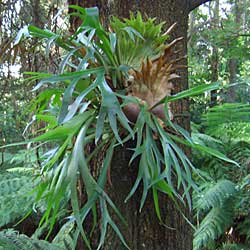 Platycerium bifurcatum, the Elkhorn fern, occurs naturally in New Guinea, and along the coasts of Queensland and New South Wales. It is cultivated in many countries, it has become naturalised (that is, it has spread into the wild) in Florida, and it has been listed as an environmentally invasive species in Hawaii. It belongs in the family Polypodiaceae, which has 10 genera and 26 species in Australia.
Platycerium bifurcatum, the Elkhorn fern, occurs naturally in New Guinea, and along the coasts of Queensland and New South Wales. It is cultivated in many countries, it has become naturalised (that is, it has spread into the wild) in Florida, and it has been listed as an environmentally invasive species in Hawaii. It belongs in the family Polypodiaceae, which has 10 genera and 26 species in Australia.
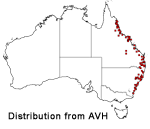 The Elkhorn fern is an epiphyte, growing on the trunks and branches of trees. Each plant is composed of a mass of plantlets. A plantlet consists of a nest leaf 12-30 cm wide, lying against the bark of the host tree. The nest leaves of neighbouring plantlets overlap one another. The nest leaves become brown and papery with age, and do not produce spores (they are sterile). Fertile fronds 25-90 cm long protrude from each plantlet. Each frond divides into two segments a number of times along its length. Spores are produced on the undersurface of the end segments of each frond. The spore producing areas are coloured tan brown, and have the texture of velvet cloth.
The Elkhorn fern is an epiphyte, growing on the trunks and branches of trees. Each plant is composed of a mass of plantlets. A plantlet consists of a nest leaf 12-30 cm wide, lying against the bark of the host tree. The nest leaves of neighbouring plantlets overlap one another. The nest leaves become brown and papery with age, and do not produce spores (they are sterile). Fertile fronds 25-90 cm long protrude from each plantlet. Each frond divides into two segments a number of times along its length. Spores are produced on the undersurface of the end segments of each frond. The spore producing areas are coloured tan brown, and have the texture of velvet cloth.
The easiest way to propagate P. bifurcatum is to remove a plantlet and then tie it to the desired new location. A large old knife, or a thin flat trowel, may be used to remove a plantlet from the rest of the plant. The implement should be inserted beneath the membrane of a plantlet and then used to prize the roots of the plantlet from the other plantlets. The plantlet may then be tied to its new location with lengths of cloth or stocking. If the new plant is required to be of a large size, then a number of plantlets can be removed together from a large P. bifurcatum plant.
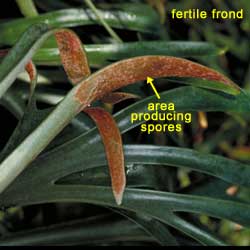 Platycerium bifurcatum may also be propagated from its spores. To collect the spores, place the part of a frond that is producing spores in a brown paper bag. Leave the frond in the bag until there is brown dust in the bag, which are the spores. Fill a plastic or terracotta pot with peat moss, and pour boiling water through the peat moss to sterilize it. Immediately place a glass or plastic sheet over the pot to keep it sterile. Once the peat moss has cooled down, spread the spores evenly over the surface of the peat moss, then immediately replace the glass or plastic sheet over the pot. Stand the bottom of the pot in an ice cream container with a shallow layer of water, and place the pot and container in a warm position receiving indirect sunlight. Once the spores have germinated, a green scum will initially appear over the surface of the peat moss. After a period of weeks to months, the fronds of the Elkhorn fern will begin to appear and the glass cover of the pot can be removed. Once the new plants have grown larger, they can be transferred to a tree trunk.
Platycerium bifurcatum may also be propagated from its spores. To collect the spores, place the part of a frond that is producing spores in a brown paper bag. Leave the frond in the bag until there is brown dust in the bag, which are the spores. Fill a plastic or terracotta pot with peat moss, and pour boiling water through the peat moss to sterilize it. Immediately place a glass or plastic sheet over the pot to keep it sterile. Once the peat moss has cooled down, spread the spores evenly over the surface of the peat moss, then immediately replace the glass or plastic sheet over the pot. Stand the bottom of the pot in an ice cream container with a shallow layer of water, and place the pot and container in a warm position receiving indirect sunlight. Once the spores have germinated, a green scum will initially appear over the surface of the peat moss. After a period of weeks to months, the fronds of the Elkhorn fern will begin to appear and the glass cover of the pot can be removed. Once the new plants have grown larger, they can be transferred to a tree trunk.
P. bifurcatum plants require a shady area to grow in, and need to be kept moist. They are not prone to attack from many pests and insects, but may be preyed upon by scale bugs and mealy bugs. These pests may be removed from the plant by scratching them off. Ladybirds will eat these pests, and so may help to control them.
Derivation of the name:Platycerium - is derived from the Greek words platys meaning "flat" and ceras meaning "a horn", referring to the shape of the fronds. bifurcatum - means to fork into two branches, again, referring to the shape of the fronds.
|
|
|
Text by Robert Mason (2004 Student Botanical Intern
Growing Native Plants
Australian National Botanic Gardens
Australian National Herbarium
bukan bangkai yang manusuk jiwa
Cinta adalah warna ,ia selalu berseri, mewarnai hidup ini
bukan menghapus ,menghilangkan, dan melenyapkan warna-warni kehidupan
Cinta adalah Smangat,ia slalu memberi motivasi dan spirit,smangat juang tuk berdiri
bukan membuat putus asa dan menyerah dari perjuangan
Cinta adalah Matahari,ia menyinari hati dengan kehangatan
bukan api yang membakar dan merangsang permusuhan
Cinta adalah Bintang ,ia menerangi malam dengan kekhusukan
bukan meteor yang menubruk bumi,sehingga menimbulkan ketegangan yang mengusik kehidupan di bumi
Cinta adalah Bulan ,ia lengkapi hati dengan cahaya cinta da iman
bukan kegelapan yang memenuhi hati dengan noda-noda kebencian
Cinta adalah pelepas dahaga
bukan kemarau yang memanggang jalannya perjuangan
Cinta adalah lautan,Luas makna ungkapan kasihnya dan begitu besar wujud abdi sayangnya
bukan sebutir biji yang bila disentil ,hilang lalu lenyap tak berada
Cinta adalah lukisan ,indah,penuh ekspresi dan emosi ,berjuta rasa mudah diingat dalam bayang-bayang kerinduan ,manis dan menggetarkan untuk dirasa,dan sejuk dijiwa
Lukisan itu terukir indah dalam hati dan sanubari
memberi ketenangan,kedamaian,kesejukan dan kebahagian maupun kesedihan beraduk menjadi satu saling berpadu
Bukan bualan-bualan gombal yg hrs dicurahkan dg kebohongan dan nafsu semata
Cinta itu Tulus,memberi perlindungan dan saling memaafkan
Cinta lebih indah bila kita bisa mengatur dan mengendalikan perasaan itu
Cinta Q Agungkan hanya Pada-Nya
Sekarang Bagaimanna langkah Kita untuk menejemen Cinta....???
Aisy Cinta Umi dan Abi
Aisy Cinta Ade-ade
And Fatimah,Hajar,Hilmi,Yusuf,As'ad, Ahmad Love Me too
Definition about love from my friends:
.cnta tu bsa membwt sdh ato pun bhagia
.cnta tdk dpt d artika sbgai apapun
.cnta hany bsa d rasakan
( naghSmaliska )
LOVE is strength...
LOVE is life...
LOVE is all about your life...
cinta yg haq hanya milik-Nya,,,
cinta yg halal adl ktika qta bHagia mencinta krna Nya...
cinta adl sesuatu yg hrus mbuat qta BahaGia...
cinta bukan skedar Kata...
cinta yang indah adl bila blasannya SUrgA...
jgn sedih krna cinta
krna itu bkn cinta...
from my best fren Luthfi
(Mba Anisa,krngpndan)
Cinta adalah obat,ia menyembuhkan
bukan racun yangmenyakitkan dan menggelisahkan
cinta adalah air ,ia menyegarkan ,menumbuhkan dan menghidupkan
bukan api yang membakar,memanaskan damn menghanguskan
Cinta adalah angin ,ia berhembus,menurunkan hujan dan menyejukkan
bukan badai yang menghancurkan ,memporak-porandakan dan merusak
Adakah Cinta selain Cinta Pada-Nya....?
(From Mr.Ihsan Fauzi)




